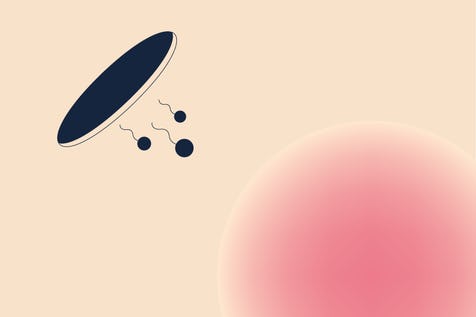Can I get pregnant on my period?
Although it is very unlikely, it is not impossible to get pregnant during, or just after, your period. This is because it is possible to be in your fertile window while you are menstruating. But what exactly is your fertile window and how can a better understanding of your menstrual cycle help you to plan or prevent pregnancy?
When am I fertile?
Contrary to popular belief, there are only a certain number of days during each cycle when having sex can result in pregnancy. This is known as the fertile window. While fertilisation can only take place on the day of ovulation - the point in your cycle when an egg is released from one of your ovaries - sperm can survive in your reproductive tract for up to five days (1). This means there are six days during each cycle when it is possible to become pregnant - the day of ovulation plus the five days before.
The exact timing of your fertile window is dependent on the length of your menstrual cycle. Because each woman has her own unique cycle - you can read more about this in our article “Diversity in Menstrual Cycles” - the timing of peak fertility varies between women (2).
If you have a shorter cycle, say 27 days or less, you are more likely to ovulate earlier (2). As a result, you will have less time between the end of your period and when you ovulate explaining the small chance of being in your fertile window while menstruating. So even though you are unable to ovulate while you are on your period, if you have sex during your period and ovulate shortly after, any surviving sperm could result in conception. As we mentioned earlier the chances of this happening are very low, with research suggesting that only 2% of women are in their fertile window by the fourth day of their cycle. This likelihood however quickly increases to 17% by day seven of the cycle (2).
Another important thing to note is the timing of your fertile window can also be different from cycle to cycle (3). This can be explained by normal variations in the length of your menstrual cycle month by month, leading to changes in the timing of ovulation (4). This is important to consider when trying to avoid pregnancy but can also make conceiving challenging. Because of this, tracking your fertile window can be a useful approach for both birth control and family planning.
When is the best time to get pregnant?
Although the fertile window is the only time in your cycle when sex can result in conception, there is no guarantee that having sex during these days will result in pregnancy. In fact, there are a number of factors which must come into play for a pregnancy to be established. These include the cervical fluids being at the correct consistency to transport the sperm to the egg (5), proper preparation of the lining of the uterus for implantation of the fertilised egg, and the survival of the egg and sperm in the reproductive tract. The last point is particularly important as unlike sperm the egg cell begins to deteriorate quickly after ovulation, lasting only 12 - 24 hours (1). When considering all this, the probability of pregnancy is thought to be highest (around 30%) when you have sex in the two days prior to ovulation. This chance quickly falls to 8 - 10% on the day of ovulation because of the short life-cycle of the egg (6).
Tracking my fertile window
Being able to track your own fertile window can be a great way to help you plan or avoid pregnancy. Through a saliva test, the inne minilab can predict your fertile window by monitoring daily changes in the levels of your hormone progesterone. By building a baseline during the first half of your cycle, the system can then detect the increase in progesterone levels that takes place during the second half, after ovulation has occurred. Even from your first logged cycle, inne can make an estimation of your fertile window. Then, as the system continues to collect your hormone data cycle by cycle, the prediction becomes more refined, even taking into account the possible variability of your ovulation day. Through the inne app you are also able to log additional events that may occur throughout your cycle, such as observations about your cervical fluids, to help you learn more about the influence of your hormones on your body and your fertility.
References
-
Wilcox, A. J., Weinberg, C. R. & Baird, D. D. Timing of sexual intercourse in relation to ovulation. Effects on the probability of conception, survival of the pregnancy, and sex of the baby. N Eng J Med. 333, 1517-1521 (1995).
-
Wilcox, A, J., Dunson, D. & Baird, D. D. The timing of the “fertile window” in the menstrual cycle: day specific estimates from a prospective study. BMJ. 321, 1259-1262 (2000).
-
Fehring, R. J., Schneider, M. & Raviele, K. Variability in the phases of the menstrual cycle. J. Obstet. Gynecol. Neonatal Nurs. 35, 376-384 (2006).
-
Chiazze, L., Brayer, F. T., Macisco, J. J., Parker, M. P. & Duffy, B. J. The length and variability of the human menstrual cycle. J. Am. Med. Assoc. 203, 377-380 (1968).
-
Bigelow, J. L., Dunson., D. B., Stanford, J. B., Ecochard, R., Gnoth, C. & Colombo, B. Mucus observations in the fertile window: a better predictor of conception than timing of intercourse. Hum Reprod. 19, 889-892 (2004).
-
Simmons, R. G. & Jennings, V. Fertility awareness-based methods of family planning. Best Pract Res Clin Obstet Gynaecol. 66, 68-82 (2020).




